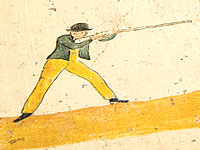
 This
is one of the painted Huon pine boards which were tied to trees in Tasmania
around 1830 as a means of communicating with the Aboriginal people. The four
panels, based on drawings by the Surveyor-General, George Frankland, were
intended to show that Aboriginal people and Europeans were equal before the law.
The top two panels show the two races mixing in harmony; the lower two panels
show their receiving the same punishment, the death penalty, for murder. In
fact, although many Aboriginal people had been executed in Tasmania, no white
person had even been charged, let alone convicted and hanged.
This
is one of the painted Huon pine boards which were tied to trees in Tasmania
around 1830 as a means of communicating with the Aboriginal people. The four
panels, based on drawings by the Surveyor-General, George Frankland, were
intended to show that Aboriginal people and Europeans were equal before the law.
The top two panels show the two races mixing in harmony; the lower two panels
show their receiving the same punishment, the death penalty, for murder. In
fact, although many Aboriginal people had been executed in Tasmania, no white
person had even been charged, let alone convicted and hanged.
Lieutenant Governor George Arthur authorised this means of communication as part
of his attempt to bring to an end the escalating interracial violence. Arthur
had declared martial law in 1828 and later, in 1830, inaugurated the infamous
Black Line which attempted to round up all the Aboriginal people on the island.
Display item Aboriginal proclamation, 1830
< Previous Exhibit | Back to The Exhibits page | Next Exhibit >